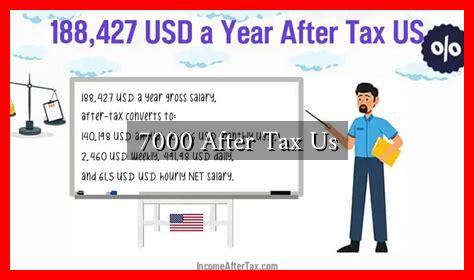-
Table of Contents
Understanding the Impact of $7,000 After Tax in the U.S.
In the realm of personal finance, understanding the implications of a specific amount of money, such as $7,000 after tax, can significantly influence financial planning and decision-making. This article delves into what $7,000 after tax means for individuals and families in the United States, exploring its purchasing power, investment potential, and implications for savings and debt management.
The Significance of $7,000 After Tax
When we talk about $7,000 after tax, we are referring to the net income that an individual or household has available for spending, saving, or investing after all applicable taxes have been deducted. This amount can vary in significance based on various factors, including location, lifestyle, and financial obligations.
Purchasing Power
Purchasing power is a critical concept when discussing any amount of money. The value of $7,000 can differ dramatically depending on where you live in the U.S. For instance:
- Urban vs.
. Rural Areas:
In urban areas like New York City or San Francisco, $7,000 may cover only a few months of rent, while in rural areas, it could stretch much further. - Cost of Living: States with a lower cost of living, such as Mississippi or Arkansas, allow $7,000 to go further in terms of housing, groceries, and other essentials.
According to the Bureau of Economic Analysis, the cost of living can vary by as much as 50% between different regions in the U.S., making it essential to consider location when evaluating the significance of $7,000 after tax.
Investment Opportunities
Investing $7,000 wisely can lead to significant financial growth over time. Here are some potential avenues for investment:
- Stock Market: Investing in stocks or ETFs can yield substantial returns. Historically, the stock market has returned an average of about 7% annually after inflation.
- Retirement Accounts: Contributing to a Roth IRA or 401(k) can provide tax advantages and compound growth over time.
- Real Estate: While $7,000 may not be enough for a down payment in many markets, it can be used for investment in real estate crowdfunding platforms.
For example, if an individual invests $7,000 in a diversified portfolio with an average annual return of 7%, they could potentially grow that investment to over $50,000 in 30 years, demonstrating the power of compound interest.
Debt Management
For many Americans, $7,000 can also play a crucial role in debt management. With the average American household carrying over $6,000 in credit card debt, having $7,000 after tax can provide a significant opportunity to reduce financial burdens.
- Paying Off High-Interest Debt: Using the funds to pay off high-interest credit cards can save thousands in interest payments over time.
- Emergency Fund: Establishing or bolstering an emergency fund can provide financial security and reduce reliance on credit in times of need.
According to a report by the Federal Reserve, nearly 40% of Americans would struggle to cover a $400 emergency expense, highlighting the importance of having accessible funds.
Conclusion
In summary, $7,000 after tax can have a profound impact on an individual’s financial landscape in the U.S. Whether it is used for purchasing power, investment opportunities, or debt management, understanding how to leverage this amount effectively is crucial for financial well-being. As the cost of living varies significantly across the country, so too does the potential impact of this sum. By making informed decisions about spending, saving, and investing, individuals can maximize the benefits of their after-tax income and work towards achieving their financial goals.
For more insights on personal finance and investment strategies, consider visiting Investopedia.





